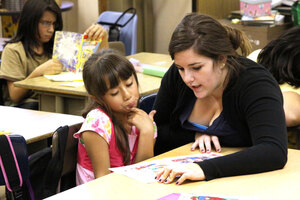USC earns top spot on ‘good neighbors’ list
Good fences make good neighbors, the saying goes, but at USC, being a good neighbor often means taking down those fences.
The university was recently ranked the top “good neighbor” in a national survey of colleges and universities — tied with the University of Pennsylvania — but USC officials and community members agree the university must continue to break down barriers between itself and the community.

Reaching out · Caren Scannell, a junior majoring in psychology, tutors a student at Vermont Avenue Elementary as part of a program through the Joint Educational Project. More than 2,000 USC students participate in JEP, an outreach program, each year. - Mike Lee | Daily Trojan
“It stems from the president’s community initiatives, which touch on education, safety, housing for USC employees, economic development and hiring,” said Cheryl Dionaldo, managing director for USC community engagement and education. “The entire university is really committed to enhancing the quality of life of the people who work, live, study, worship and play around our neighborhoods.”
The survey was released as a part of the report, “Saviors of Our Cities: A Survey of Best College and University Civic Partnerships,” led by Evan S. Dobelle, president of Westfield State College. This is the second time Dobelle has released a survey concerning civic engagement at universities — the first was published in 2006, with USC again landing at the top of the list — and serves as a re-evaluation based on the economic recession.
To determine the top 25 universities for the list, Dobelle studied a series of criteria including the school’s length of involvement with the community, the amount of money invested, faculty and student involvement in community service and recognition of the school’s presence within its community. USC has long touted its student and faculty outreach programs and its investment in the community.
“At USC we don’t just say we’re doing this much for the community around us, but the actual funds that go to finance those programs come from USC faculty and staff,” Dionaldo said.
Members of the community agree the university is taking the right steps. Shawn Simons, president of the North Area Neighborhood Development Council, believes that the university works hard to understand the needs of the community.
“That’s really the best way for the university to go,” she said.
But Simons, who lives off Normandie Avenue, believes the university needs to make its outreach programs better known within the community.
“Their biggest obstacle is getting the word out so everybody knows about those programs,” she said. “There is some unrest in the community about the relationship, but I think those people don’t really fully understand the extent that USC has taken with their different programs.”
Daniel Wu, an outreach coordinator for Campus and Community United, said he is proud of USC’s No. 1 ranking but believes this should prompt university officials and students to continue their efforts.
“This is a milestone to push USC to go above and beyond,” said Wu, a senior majoring in interdisciplinary studies. “Now we can think of new ways to approach community issues.”
Wu cited employment opportunities and increased affordable housing as two initiatives that USC should take to the next level.
“As a campus, we really can’t be afraid to think about larger community problems,” he said.
Many of those larger community issues will come into focus in the next few years as USC moves forward with its Master Plan, which includes rebuilding the University Village and creating more student housing.
One problem already plaguing the community is education. With the Los Angeles Unified School District’s programs lagging, USC has stepped in, partnering with a network of 14 schools ranging from kindergarten to 12th grade in the areas surrounding the University Park and Health Sciences campuses.
Through the collaboration with these schools — known as the USC Family of Schools — the university provides funding and support for academics, tutoring, after school programs and college-readiness programs.
“Due to that partnership, we have so many opportunities for our children,” said Sue Becker, magnet coordinator for the K-8 school at the 32nd Street/USC Visual and Performing Arts Magnet School. “We have so many fantastic things offered to us because of the outreach and community partnership that USC has with the school.”
The university has helped the magnet school provide its students with dance and music classes, science activities and specialized tutoring, but Becker said that the most important aspect of the partnership is the commitment of USC students.
“Everybody is just so thoughtful and considerate,” she said. “It gives the students the opportunity to know someone who is in college. Knowing that, it gives them an understanding that college is available to them and that they too can get there.”
For Simons, student involvement is the key to eliminating the remaining fences between the university and its neighbors.
“The more USC can partner with the community and educate them about their true passion for the students to be civically engaged, the better off everyone can be,” he said.
